This is an AI Free Zone! Text created by Large Language Models is spreading rapidly across the Internet. It's well-written, artificial, frequently inaccurate. If you find a mistake on Spaceweather.com, rest assured it was made by a real human being. | | |
EARTH ISN'T THE ONLY PLANET WITH SPACE WEATHER: A pair of CMEs launched from the farside of the sun on June 17th are approaching Mercury and Venus. The double-strike on Mercury (today) will pepper the planet's rocky surface with high energy electrons, igniting X-ray auroras at ground level. The impact on Venus (tomorrow) will likely erode a small amount of the planet's upper atmosphere. Solar flare alerts: SMS Text
SUPERSTORM ZAPS THE GLOBAL ELECTRIC CIRCUIT: The geomagnetic superstorm of May 10, 2024, did more than spark some of the best auroras in 500 years. It also electrified our planet.
"Our sensors measured a significant change in atmospheric electricity," reports Prof. Gang Li, a space physicist at the University of Alabama. "Earth's entire global electrical circuit was affected by the storm."
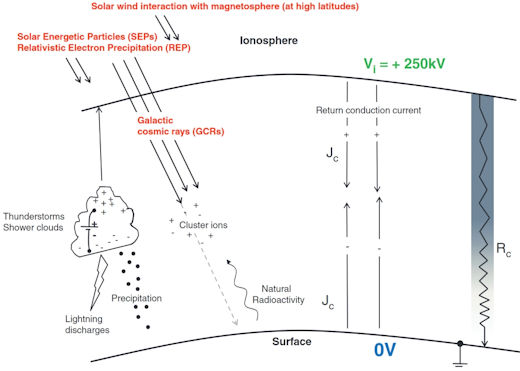
Credit: K. A. Nicoll's 2014 review paper "Space Weather influences on Atmospheric Electricity" [ref]
Yes, Earth has a "global electrical circuit." It is created by thunderstorms, which build up a charge difference between the ground and the ionosphere 50 km overhead. There are about 40,000 thunderstorms per day all over the Earth, and we can think of them as batteries pumping the electricity to the top of the atmosphere. The resulting voltage drop is a staggering 250,000 volts.
On its own, air is not a great conductor of electricity. However, cosmic rays from deep space ionize our atmosphere, creating just enough conductivity for currents to flow in response to those 250,000 volts. The very air you breath is thus electrified.
In April 2024, Li and colleagues published a paper in the journal Space Weather about solar storms and the global electric circuit. They described how CMEs approaching Earth sweep aside cosmic rays, decreasing their intensity. This is called a "Forbush Decrease," named after American physicist Scott Forbush who studied cosmic rays in the early 20th century. During a Forbush Decrease, fewer cosmic rays are available to ionize Earth's atmosphere; this, in turn, changes the conductivity of the entire global electrical circuit. Li's team found that large Forbush Decreases boosted electric fields in the atmosphere.
The CME that hit Earth on May 10, 2024, caused a very large Forbush Decrease. "It was a boon to our research," says Li.
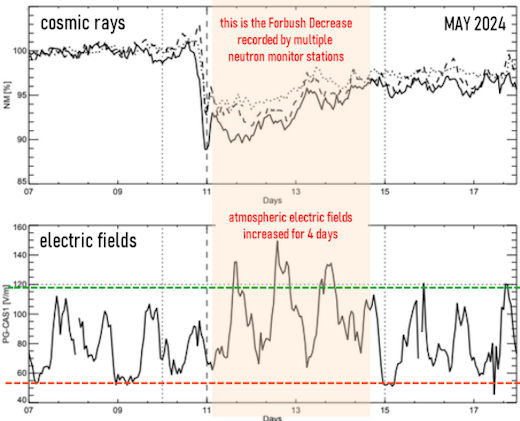
Li and colleagues checked two electric field monitoring stations at the CASLEO observatory in Argentina--a site they often use to monitor the global electrical circuit. During the May 10th superstorm, electric fields jumped 10% to 15%, an increase that lasted for more than four days. "This is in good accord with what we would have predicted based on our paper," he says.
Such changes in atmospheric electricity can affect many things ranging from the probability of rain and lightning to the flight paths of ballooning spiders, which ride electric fields through the air. Indeed, arachnids may have known of this phenomenon all along, but humans are only learning about it now.
Read Li's original research
here.
Realtime Space Weather Photo Gallery
Free: Spaceweather.com Newsletter
HANDMADE TOTAL ECLIPSE PENDANT: On April 8, 2024, the students of Earth to Sky Calculus launched a cosmic ray research balloon to the stratosphere. This handmade pendant went along for the ride. Floating more than 118,110 feet high, the it spent 3 minutes and 45 seconds wrapped in the shadow of the Moon:
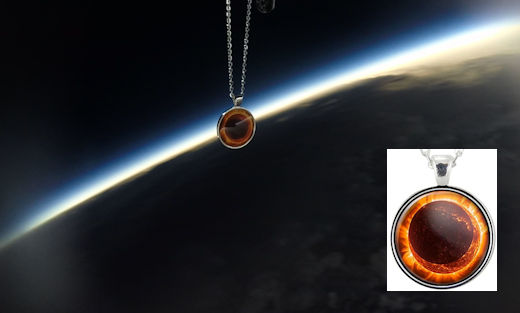
You can have it for $179.95. Created by an artist in Texas where totality occured, the pendant displays a solar eclipse art print sealed under a smooth glass cover. It comes with a greeting card showing the pendant in flight and telling the story of its journey to the edge of space during the total eclipse.
Far Out Gifts: Earth to Sky Store
All sales support hands-on STEM education
Realtime Comet Photo Gallery
Free: Spaceweather.com Newsletter
Realtime Aurora Photo Gallery
Free: Spaceweather.com Newsletter
Realtime Noctilucent Cloud Photo Gallery
Free: Spaceweather.com Newsletter
Every night, a network of
NASA all-sky cameras scans the skies above the United States for meteoritic fireballs. Automated software maintained by NASA's Meteoroid Environment Office calculates their orbits, velocity, penetration depth in Earth's atmosphere and many other characteristics. Daily results are presented here on Spaceweather.com.
On Jun 17, 2024, the network reported 12 fireballs.
(11 sporadics, 1 June mu Cassiopeiid)
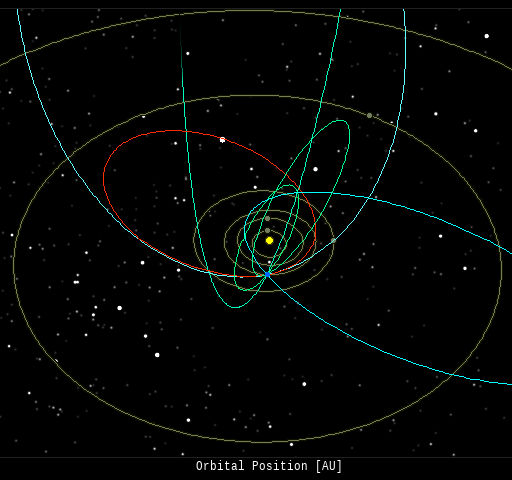
In this diagram of the inner solar system, all of the fireball orbits intersect at a single point--Earth. The orbits are color-coded by velocity, from slow (red) to fast (blue). [Larger image] [movies]
Potentially Hazardous Asteroids (
PHAs) are space rocks larger than approximately 100m that can come closer to Earth than 0.05 AU. None of the known PHAs is on a collision course with our planet, although astronomers are finding
new ones all the time.
On June 18, 2024 there were 2349 potentially hazardous asteroids.
 |
Recent & Upcoming Earth-asteroid encounters: | Asteroid | Date(UT) | Miss Distance | Velocity (km/s) | Diameter (m) |
| 2024 LS5 | 2024-Jun-13 | 6.4 LD | 16.5 | 23 |
| 2024 LR5 | 2024-Jun-14 | 3.9 LD | 5.8 | 8 |
| 2024 LZ2 | 2024-Jun-14 | 3.5 LD | 20.4 | 21 |
| 2024 MB | 2024-Jun-14 | 9.3 LD | 7.7 | 25 |
| 2024 LL1 | 2024-Jun-15 | 5.2 LD | 9.2 | 21 |
| 2024 LS4 | 2024-Jun-15 | 11.1 LD | 4.8 | 23 |
| 2024 LZ4 | 2024-Jun-16 | 0.7 LD | 21.4 | 22 |
| 2024 LB4 | 2024-Jun-16 | 7.6 LD | 7.6 | 29 |
| 2024 LH3 | 2024-Jun-16 | 13 LD | 6.1 | 49 |
| 2024 MD | 2024-Jun-17 | 1 LD | 5.8 | 9 |
| 2024 LU1 | 2024-Jun-17 | 4.8 LD | 7.1 | 23 |
| 2022 WW11 | 2024-Jun-17 | 19.7 LD | 14.4 | 15 |
| 2024 KW1 | 2024-Jun-17 | 19.8 LD | 4 | 28 |
| 2024 MA | 2024-Jun-18 | 4.2 LD | 11.2 | 17 |
| 2024 KY1 | 2024-Jun-19 | 16.1 LD | 12.2 | 36 |
| 2024 MC | 2024-Jun-19 | 6.5 LD | 14.3 | 60 |
| 2024 LO3 | 2024-Jun-20 | 1.9 LD | 8 | 20 |
| 2024 LG5 | 2024-Jun-21 | 6.1 LD | 7.5 | 17 |
| 2024 LO2 | 2024-Jun-21 | 14.2 LD | 9.1 | 28 |
| 2024 LJ | 2024-Jun-22 | 8.8 LD | 18.5 | 69 |
| 2024 KN1 | 2024-Jun-23 | 14.6 LD | 4.6 | 28 |
| 2024 KJ | 2024-Jun-25 | 13.7 LD | 4.5 | 25 |
| 2024 LO5 | 2024-Jun-25 | 5.1 LD | 7.9 | 20 |
| 2019 NJ | 2024-Jun-27 | 17.2 LD | 10.1 | 66 |
| 415029 | 2024-Jun-27 | 17.3 LD | 25.9 | 2304 |
| 2022 MM1 | 2024-Jun-28 | 7.8 LD | 10.9 | 39 |
| 2010 XN | 2024-Jun-28 | 14.1 LD | 11.3 | 52 |
| 2022 HD1 | 2024-Jun-29 | 17.3 LD | 7.2 | 63 |
| 2017 MB3 | 2024-Jun-30 | 5 LD | 6.5 | 30 |
| 2024 JJ25 | 2024-Jun-30 | 10.5 LD | 9.4 | 117 |
| 2024 LJ2 | 2024-Jul-01 | 19.8 LD | 10.4 | 84 |
| 2022 BY39 | 2024-Jul-02 | 13.2 LD | 3 | 4 |
| 2024 LH | 2024-Jul-02 | 4.4 LD | 4.3 | 32 |
| 2024 KQ1 | 2024-Jul-04 | 14.9 LD | 6.9 | 57 |
| 2022 YS5 | 2024-Jul-11 | 11 LD | 5.8 | 38 |
| 2024 BY15 | 2024-Jul-16 | 16.2 LD | 0.7 | 16 |
| 2024 LY2 | 2024-Jul-23 | 12 LD | 7.8 | 88 |
| 2011 MW1 | 2024-Jul-25 | 10.1 LD | 8 | 120 |
| 2011 AM24 | 2024-Jul-26 | 16.8 LD | 6.2 | 281 |
| 523664 | 2024-Jul-28 | 14.9 LD | 23.7 | 680 |
| 2020 PN1 | 2024-Aug-02 | 18 LD | 5.5 | 29 |
| 2023 HB7 | 2024-Aug-05 | 14.6 LD | 6.1 | 32 |
| 2017 TU1 | 2024-Aug-05 | 10.1 LD | 10.1 | 22 |
| 2024 KH3 | 2024-Aug-10 | 14.6 LD | 11.4 | 195 |
| 2021 GY1 | 2024-Aug-16 | 17.7 LD | 6.3 | 59 |
Notes: LD means "Lunar Distance." 1 LD = 384,401 km, the distance between Earth and the Moon. 1 LD also equals 0.00256 AU. | | Cosmic Rays in the Atmosphere |
SPACE WEATHER BALLOON DATA: Almost once a week, Spaceweather.com and the students of Earth to Sky Calculus fly space weather balloons to the stratosphere over California. These balloons are equipped with sensors that detect secondary cosmic rays, a form of radiation from space that can penetrate all the way down to Earth's surface. Our monitoring program has been underway without interruption for 7 years, resulting in a unique dataset of in situ atmospheric measurements.
Latest results (July 2022): Atmospheric radiation is decreasing in 2022. Our latest measurements in July 2022 registered a 6-year low:
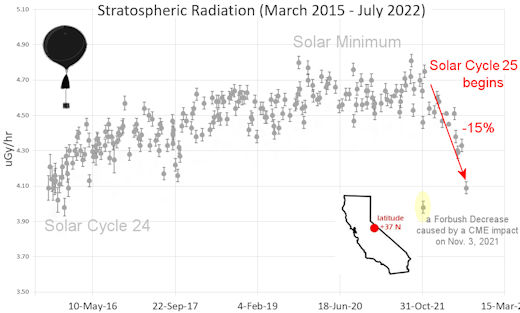
What's going on? Ironically, the radiation drop is caused by increasing solar activity. Solar Cycle 25 has roared to life faster than forecasters expected. The sun's strengthening and increasingly tangled magnetic field repels cosmic rays from deep space. In addition, solar coronal mass ejections (CMEs) sweep aside cosmic rays, causing sharp reductions called "Forbush Decreases." The two effects blend together to bring daily radiation levels down.
.Who cares? Cosmic rays are a surprisingly "down to Earth" form of space weather. They can alter the chemistry of the atmosphere, trigger lightning, and penetrate commercial airplanes. According to a study from the Harvard T.H. Chan school of public health, crews of aircraft have higher rates of cancer than the general population. The researchers listed cosmic rays, irregular sleep habits, and chemical contaminants as leading risk factors. A number of controversial studies (#1, #2, #3, #4) go even further, linking cosmic rays with cardiac arrhythmias and sudden cardiac death.
Technical notes: The radiation sensors onboard our helium balloons detect X-rays and gamma-rays in the energy range 10 keV to 20 MeV. These energies span the range of medical X-ray machines and airport security scanners.
Data points in the graph labeled "Stratospheric Radiation" correspond to the peak of the Regener-Pfotzer maximum, which lies about 67,000 feet above central California. When cosmic rays crash into Earth's atmosphere, they produce a spray of secondary particles that is most intense at the entrance to the stratosphere. Physicists Eric Regener and Georg Pfotzer discovered the maximum using balloons in the 1930s and it is what we are measuring today.
| | The official U.S. government space weather bureau |
| | The first place to look for information about sundogs, pillars, rainbows and related phenomena. |
| | Researchers call it a "Hubble for the sun." SDO is the most advanced solar observatory ever. |
| | 3D views of the sun from NASA's Solar and Terrestrial Relations Observatory |
| | Realtime and archival images of the Sun from SOHO. |
| | information about sunspots based on the latest NOAA/USAF Active Region Summary |
| | current counts of failed and deployed Starlink satellites from Jonathan's Space Page. See also, all satellite statistics. |
| | Authoritative predictions of space junk and satellite re-entries |
| | from the NOAA Space Environment Center |
| | fun to read, but should be taken with a grain of salt! Forecasts looking ahead more than a few days are often wrong. |
| | from the NOAA Space Environment Center |
| | the underlying science of space weather |
 | Got a chipped or cracked windshield that prevents you from seeing space weather events while driving? Get windshield replacement from SR Windows & Glass with free mobile auto glass service anywhere in the Phoenix area. |
 | Marketing yourself on YouTube is hard without real organic views on your videos. You can buy organic YouTube views from and enjoy social boosting that is actually real. Highly recommended! |
 | BestCSGOGambling is the best site for everything related to CSGO gambling on the web |
| | These links help Spaceweather.com stay online. Thank you to our supporters! |
| | | | | | |

